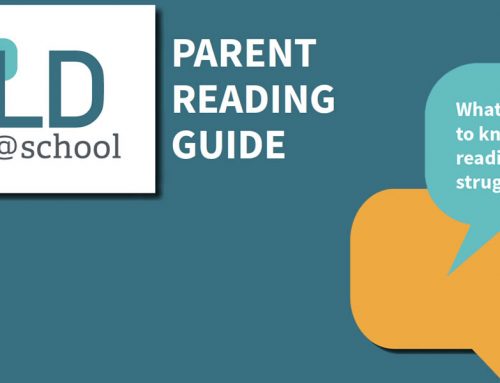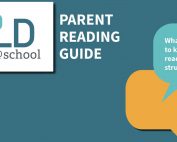Adapted from a question answered by Nathalie Paquet-Bélanger
Reading is not an innate or natural process; everyone must learn to read, starting from the basics. Children with learning disabilities (LDs) may progress at a slower rate than other children, but, with the right support, they can become competent and confident readers.
LDs that impact reading are diverse, and may take many different forms. Most children with learning disabilities that affect their ability to read, struggle with:
- Breaking down the sounds of spoken language
- Recognizing words
It is important to remember that no two children are the same, and each child will learn to read at his or her own pace. LDs will also present differently in each child, so take time to get to know your child’s unique strengths and needs. Remember to help them leverage their strengths when faced with challenging tasks, such as reading.
Parents play a significant role in supporting children’s reading development, from a very young age, all the way through the elementary school years. The following is a list of tips you can use at home to help improve your child’s reading skills.
Tip #1: Instill a love of reading
Good readers are not only able to read fluently and understand what they read, but they also have a strong motivation to read. There are many ways in which to promote the importance of reading, and instill a life-long love of reading:
- Let your child see you reading.
- Have books, magazines, newspapers, and other reading materials in the home. If you don’t have access to books and magazines at your child’s reading level, there are lots of websites that offer digital libraries, like Epic! (https://www.getepic.com/), which offers free membership to educators and free 30 day trials for parents.
- Set aside designated time (ie. 30 minutes before bed) for all family members to engage in reading.
- Visit libraries and bookstores with your child, when you can. Many public libraries also offer OverDrive, which allows you to download ebooks, audiobooks, and magazines directly to your phone or tablet at no cost. All you need is your library card!
Tip #2: Introduce activities that develop phonological awareness
Phonological awareness related to the ability to hear, identify, and manipulate the small units of sound (called phonemes) that make up words.
Good phonological awareness is a prerequisite for learning to read; it is also one of the best predictors of the likelihood that a student will stay in school later on. There are many fun activities that you can take part in at home to help develop your child’s phonological awareness, such as:
- Delete a sound to make new words: “What word would be left if the /k/ sound were taken away from cat?” Or, at a more difficult level, “Say the word ‘play.’ Now say it again but don’t say /p/.”
- Word to word matching: “Do pen and pipe begin with the same sound?”
- Have your child break down a word into its individual sounds: “What sounds do you hear in the word ‘hot’?”
- Break down words into their individual sounds and have your child blend the sounds together again: “What word would we have if we blended these sounds together: /m/ /o/ /p/?”)
- Count the sounds: “How many sounds do you hear in the word ‘cake’?” (Three: /k/ /ā/ /k/)
- Rhyming: “Tell me all of the words that you know that rhyme with the word ‘cat’.”
Tip #3: Introduce activities that develop morphological awareness
Morphological awareness is the understanding that words can be broken down into smaller units of meaning (called morphemes). For instance, the word unzipped has three morphemes: the prefix un- which means “not” or “opposite;” the root or base word zip; and the suffix –ed which indicates that this was an action done in the past.
Understanding these building blocks of words helps your child figure out the meaning of unfamiliar words.
If you want to improve your child’s morphological awareness, click here to view and download the Build-A-Word game.
Tip #4: Read with your child
Children also learn to read by listening to a good reader; parents should, therefore, read parts of a story or the entire story aloud to their child. Reading at home is an accessible way to have a positive impact on reading fluency (how quickly your child reads) and comprehension (how much of the reading is understood and integrated with what your child already knows).
Fluency
Where fluency is concerned, children must enjoy the activity. Certain simple behaviours make reading more enjoyable:
- Use different voices for different characters in a story
- Act out some of the parts of the story
- Imitate sounds through the use of onomatopoeia (ie. boom, crash, bang)
Comprehension
Reading comprehension begins before a student starts reading, and continues after they have finished. Ask your child questions to encourage reflection before, during, and after storytime. This will make the activity interactive and support the development of comprehension strategies.
For example:
Before: let’s look at the pictures together. What do you think this story is about?
During: what do you think is going to happen next? Why?
After: if you were a character in this story, would you have behaved that way? Can you tell me why?
For older children, you can use a graphic organizer, like KWL to help then organize their thoughts and support reading comprehension. Click here to access the LD@school article The KWL Strategy
Another tool that can be used with older students to support the development of reading comprehension skills is the SQ3R mnemonic (Survey, Question, Read, Recite, Review). This mnemonic helps to structure and guide the reading process in order to develop effective reading skills for comprehension. Click here to open a PDF description of the SQ3R mnemonic from the LD@school website.
Tip #5: Talk to your child’s teacher
Educators are really good at judging the complexity and suitability of a book. Your child’s teacher can provide you with a reading list, appropriate for your child’s reading level. You may also want to ask your child’s teacher what concepts their class is currently studying. That way you can reinforce your child’s learning by engaging in similar activities at home.










